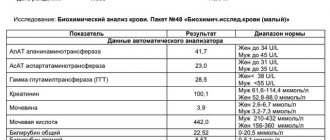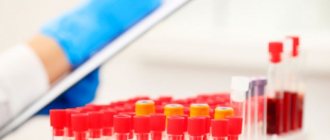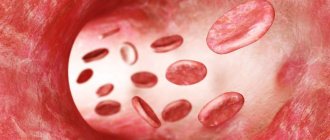In a healthy state, the body produces the substance during the processing of proteins and removes it through the gastrointestinal tract and kidneys. Uric acid can be elevated if there is a failure in its elimination or if it is over-produced by the liver.
An analysis for the determination of uric acid in the blood is important in the diagnosis of kidney diseases, gout, arthrosis and arthritis, since over time it transforms into crystals that accumulate in the joints, kidneys, gastrointestinal tract, heart and eye chambers.
Concept of uric acid in blood
Uric acid is defined as a substance formed as a result of the breakdown of nucleic compounds and purines under the influence of enzymes. It was discovered in the 18th century as part of urine and the stones present in it.
It is not used in the body's work and is classified as nitrogenous waste - the final product of purine metabolism. When a substance is formed in an excessive volume, the kidneys are not able to remove it completely; it enters the blood, so the concentration in the blood plasma increases. An increase in uric acid in the blood is called hyperuricemia.
The level of uric acid in the body is affected by:
- the amount of animal protein coming from food;
- metabolic rate;
- age;
- gender - in men, due to greater muscle volume, heavy loads and the presence of protein in the diet, the level is higher than in women.
Donating blood to determine the concentration of a substance allows you to assess the metabolism of purines in the body, the volume of their intake, transformation and excretion through the kidneys. Thus, the doctor draws conclusions about the functioning of the hematopoietic system, kidneys and liver, and muscle fibers.
Most often, the analysis is used to diagnose gout, monitor the tolerability of chemotherapy, to identify urolithiasis and evaluate the functioning of the urinary system in general and its individual components.
Interpretation of biochemical analysis in adults
A biochemical blood test contains 9 main indicators:
- Glucose. Displays the amount of sugar in the blood. Normally, the glucose level is from 3.5 to 6 - these numbers in the analysis indicate that the body absorbs it without problems. If your fasting glucose level is 6.5 or higher, then you should consult a doctor as soon as possible - there is a risk of diabetes.
- Total cholesterol. This indicator should normally not exceed 5.2. High cholesterol indicates a risk of atherosclerotic vascular disease, angina pectoris and heart disease.
- Total bilirubin. The normal indicator is from 5 to 21 for an adult; the indicators for newborns differ significantly. An increased value of total bilirubin indicates problems with the liver: pathologies may include hepatitis and diseases of the biliary tract.
- Transaminases. The doctor pays attention not to the number of different transaminases, but to their proportional ratio.
- Total protein. Its norms for adults range from 65 to 85 g/l. The level of protein in plasma can tell the doctor about problems in the kidneys, liver, pancreas, and also identify disorders of protein, lipid and carbohydrate metabolism.
- Urea and creatinine. These two indicators reflect the functioning of the kidneys. The norm for urea is 2.2 - 7.3 mmol / l, the level of creatinine greatly depends on the weight and physical activity of the patient.
- Iron. The norm for this element is 12.5-32.3 µmol/l for men and 0.7-32.3 µmol/l for women. It is better to check your iron as often as possible, since without a sufficient amount of hemoglobin the body cannot function fully.
- C-reactive protein - this protein begins to be synthesized by the liver at the beginning of the inflammatory process. Therefore, its presence in the blood indicates the presence of the disease.
- Uric acid. Its norm is up to 428 µmol/l; exceeding this level is dangerous due to the appearance of arthritis and gout.
What indicator is considered normal?
During puberty, the amount of uric acid begins to gradually increase and reach levels characteristic of adults.
Men have more stable values throughout life: from 210 to 420 µmol/l.
For women of reproductive age, the level decreases due to the hormone estrogen and ranges from 150 to 350 µmol/l. When reaching the age of decline of childbearing function, the concentration increases.
The limit value, the achievement of which serves as a basis for recognizing hyperuricemia, is 360 µmol/l. At this value, the likelihood of gout in men increases by four times, in women by seventeen times. A lower value does not prevent the dissolution of urate crystals and prevent their formation.
Thus, the level of uric acid in the blood is as follows:
- in children under 14 years of age – from 120 to 320 µmol/l;
- in women – from 150 to 320 µmol/l;
- in men – from 210 to 420 µmol/l;
- at the age of 65 years – up to 500 µmol/l.
The tests must be interpreted by a doctor who evaluates several indicators in combination.
Biochemical blood test (BAC) – by whom and when is it prescribed, how to prepare for the study
The first test that a therapist prescribes when complaining of deterioration in health is a biochemical blood test.
Also, all those undergoing preventive examinations and medical examinations are sent for examination. The blood test does not require much preparation. It is enough to follow the following rules:
- blood is donated in the morning, before meals;
- The day before the test, it is forbidden to drink alcohol and fatty foods. The night before the test, exclude sweets, strong tea and coffee from your diet;
- It is advisable to arrive 15 minutes before the blood draw, calm down and catch your breath.
You can take a biochemical test in Moscow at the Evermedic clinic. Our specialists will carefully and almost painlessly collect material from even the thinnest veins. The laboratory will produce the results of the biochemical analysis within 1 day - a table with the results can be picked up either in person or received by mail.
Below we will provide a breakdown of the analysis for adults, however, you need to understand that this information cannot be used for self-diagnosis and self-prescription of drugs. The interpretation of indicators and diagnosis should be carried out exclusively by the doctor, who makes a conclusion based on the medical history.
Causes of increased uric acid in the blood
Reasons why uric acid in the blood is elevated include:
- gout;
- pathologies of the endocrine glands;
- blood diseases, including leukemia;
- a disease of hereditary nature, expressed in enzyme deficiency and increased production of uric acid in childhood (Lesch-Nyhan syndrome);
- multiple myeloma;
- cancer of the lymphatic system;
- anemia caused by vitamin B12 deficiency;
- kidney pathologies, including polycystic disease, renal failure, kidney stones;
- disproportionate growth of body parts due to hormonal imbalance;
- diabetes;
- hypoparathyroidism;
- eating disorders: abuse of alcoholic beverages, protein foods or prolonged abstinence from food;
- excess body weight, atherosclerosis;
- hypertension, ischemic heart disease,
- the use of certain drugs - diuretics, aspirin, antitumor drugs;
- complication of pregnancy with toxicosis;
- neoplasms of a malignant nature.
Knowing the cause of hyperuricemia is important for choosing treatment methods and preventing dangerous complications.
Reasons for low uric acid in the blood
The level of uric acid in the blood may be low if:
- Konovalov-Wilson disease, manifested in excessive accumulation of copper in the body and serious damage to systems and organs;
- congenital pathology of the renal tubules;
- xanthinuria;
- taking medications for gout, drugs for contrast X-rays, immunosuppressants, steroid hormones;
- lymphogranulomatosis;
- diet low in purines.
Detection of low levels is less common; a specialist should draw conclusions about pathology or a variant of the norm.
Blood urea level test
Short description:
Urea is one of the end products of protein metabolism, containing nitrogen. It is produced in the liver, transported by the blood to the kidneys, where it is filtered through the glomerulus and then excreted. The blood urea test result is an indicator of glomerular production and urine excretion. The accumulation of urea and other nitrogen-containing compounds in the blood due to renal failure leads to uremia. Synonyms (rus): Carbonic acid diamide, urea, urea in the blood. Synonyms (eng): Urea nitrogen, Urea, Blood Urea Nitrogen (BUN), Urea, Plasma Urea.
Method: UV kinetic using urease and glutamate dehydrogenase.
Units of measurement: mmol/l (millimoles per liter).
Preparing for the study:
• Do not eat for 12 hours before the test. • Avoid physical and emotional stress and do not smoke 30 minutes before donating blood.
Type of biomaterial: Venous blood. Type of tube: vacuum tube with clotting activator and separating gel (red cap with yellow ring).
Service price: 60 rub.
Completion time: one business day.
Reference values:
Age, gender Reference values: < 4 years 1.8 - 6 mmol/l 4 - 14 years 2.5 - 6 mmol/l 14-20 years 2.9 - 7.5 mmol/l 20 - 50 years male 3, 2 - 7.3 mmol/l female 2.6 - 6.7 mmol/l > 50 years old male 3.5 - 8.2 mmol/l female 3.0 - 7.2 mmol/l
Reasons for increased urea levels in the blood: • decreased kidney function caused by congestive heart failure, loss of salts and fluids, shock combined with excessive protein catabolism (gastrointestinal bleeding, acute myocardial infarction, stress, burns), • chronic kidney disease (pyelonephritis , glomerulonephritis, amyloidosis, renal tuberculosis, etc.), • obstruction of the urinary tract (bladder tumor, prostate adenoma, urolithiasis, etc.), • bleeding from the upper gastrointestinal tract (peptic ulcer of the stomach, duodenum, cancer of the stomach, duodenum etc.), • diabetes mellitus with ketoacidosis, • increased protein catabolism in cancer, • taking corticosteroids, nephrotoxic drugs, tetracyclines, excess thyroxine, • use of anabolic steroids, • high protein diet (meat, fish, eggs, cheese, cottage cheese).
Reasons for a decrease in the level of urea in the blood: • liver failure, some liver diseases: hepatitis, cirrhosis, acute hepatodystrophy, liver tumors, hepatic coma, poisoning with hepatotoxic poisons, drug overdose (this disrupts the synthesis of urea), • acromegaly (a hormonal disease characterized by increased production of growth hormone), • fasting, low-protein diet, • impaired intestinal absorption (malabsorption), for example, with celiac disease, • nephrotic syndrome (increased excretion of protein in the urine, hyperlipidemia, decreased protein levels in the blood), • increased production of antidiuretic hormone ( ADH) and, as a consequence, pathological hypervolemia, • pregnancy (increased protein synthesis and increased renal filtration cause a decrease in the amount of urea in pregnant women).
Code A09.05.017
Urea
Urea is the main breakdown product of proteins. It is the chemical form in which nitrogen that the body does not need is removed through urine.
Research method
UV kinetic test.
Units
mmol/l (millimoles per liter).
What biomaterial can be used for research?
Venous, capillary blood.
How to properly prepare for research?
- Do not eat for 12 hours before the test.
- Avoid physical and emotional stress and do not smoke 30 minutes before donating blood.
General information about the study
Urea is one of the end products of protein metabolism, containing nitrogen. It is produced in the liver, transported by the blood to the kidneys, where it is filtered through the glomerulus and then excreted. The blood urea test result is an indicator of glomerular production and urine excretion.
Rapid protein breakdown and kidney damage rapidly raise blood urea levels.
The amount of urea released is directly dependent on the level of protein consumed by a person; the reasons for an increase in urea in the blood are feverish conditions, complications of diabetes, and increased hormonal function of the adrenal glands. Elevated urea levels are a marker of decreased glomerular filtration.
Urea is one of the main metabolites in the blood; the body does not use it in any way, but only gets rid of it. Since this excretion process is continuous, a certain amount of urea is normally always present in the blood.
What is the research used for?
- To assess kidney function in a range of conditions (in conjunction with a creatinine test).
- For the diagnosis of kidney disease and for checking the condition of patients with chronic or acute renal failure.
What do the results mean?
Reference values (norm of urea in blood):
| Age, gender | Reference values |
| 1.8 - 6 mmol/l | |
| 4 – 14 years | 2.5 - 6 mmol/l |
| 14-20 years | 2.9 - 7.5 mmol/l |
| 20 – 50 years old, male | 3.2 - 7.3 mmol/l |
| 20 – 50 years, female | 2.6 - 6.7 mmol/l |
| > 50 years old, male | 3 - 9.2 mmol/l |
| > 50 years old, female | 3.5 - 7.2 mmol/l |
Reasons for increased urea levels in the blood:
- decreased kidney function,
- chronic kidney disease,
- obstruction of the urinary tract (bladder tumor, prostate adenoma, urolithiasis, etc.),
- bleeding from the upper gastrointestinal tract (peptic ulcer of the stomach, duodenum, cancer of the stomach, duodenum, etc.),
- diabetes mellitus with ketoacidosis,
- increased protein catabolism in cancer,
- taking corticosteroids, nephrotoxic drugs, tetracyclines, excess thyroxine,
- use of anabolic steroids,
- high protein diet.
Reasons for low urea levels in the blood:
- liver failure,
- some liver diseases,
- acromegaly,
- fasting, low protein diet,
- intestinal malabsorption,
- nephrotic syndrome,
- pregnancy (increased protein synthesis and increased renal filtration cause a decrease in the amount of urea in pregnant women).
What can influence the result?
In children and women, the level of urea in the blood is slightly lower due to lower muscle mass than in men.
A decrease in the level of this indicator occurs during pregnancy due to an increase in blood volume.
general characteristics
Blood urea nitrogen is considered to be the nitrogen contained in the end products of protein metabolism, and in particular in urea (one urea molecule contains 2 nitrogen molecules). Urea is formed in the liver from ammonia during its neutralization and is excreted through the kidneys, making up 40-50% of the non-protein nitrogen in the blood. Urea nitrogen in the blood reflects the state of protein metabolism (excretory function of the kidneys). An increase in blood levels indicates impaired renal function, and is therefore used to assess their function. Urea nitrogen also allows you to determine liver function, active inflammatory process, rheumatic process, as well as a violation of water-salt metabolism and an imbalance of microelements. Biochemical analysis helps to make a diagnosis, prescribe and adjust treatment.
How to determine the type of infection using a blood test
Depending on the increase or decrease in certain blood parameters, we can assume what type of infection the patient has. We warn you that only a specialist should decipher the tests. Therefore, with the help of a doctor, we will only conduct a small educational program on this topic. It is useful to know such information, but making a diagnosis yourself is very dangerous, because in some cases a blood test may show an atypical picture.
How to determine the type of infection using blood tests? Polina Panteleimonova, an allergist-immunologist at the SM Clinic in St. Petersburg (@smclinicspb), answered this question to Letidor.
The interpretation of the tests should be done exclusively by a doctor. Only a specialist can draw the right conclusions and prescribe further treatment.
But in general, it will be useful to understand for yourself what illnesses you or a loved one have. Let's start with the fact that there are different types of inflammation - bacterial, viral, fungal, parasitic. Everyone has different triggers. For a person, they may not differ in any way in terms of external symptoms - runny nose, cough, fever. But for a doctor, there are a number of signs by which the type of infection can be determined using standard examination methods, for example, a blood test.
If you have the result of a clinical blood test in your hands, pay attention to leukocytes, neutrophils, and lymphocytes.
- If leukocytes and neutrophils are elevated, you can think about a bacterial infection.
- With elevated lymphocytes - about viral. Lymphocytosis (an increase in lymphocytes in a clinical blood test) may be accompanied by the appearance of monocytes and wide-plasma lymphocytes (the latter are cells that appear in patients with infectious mononucleosis, that is, a special type of viral process).
- In a biochemical blood test, inflammation can be indicated by elevated C-reactive protein, antistreptolysin O, urea, and fibrinogen.
- As a rule, C-reactive protein increases with bacterial infections, antistreptolysin O only with streptococcal infections.
It makes sense to evaluate the remaining markers of inflammation only in conjunction with the results of a clinical blood test.
There are also parasitic and allergic inflammations. Their signs are ironically the same and always require more careful study. In this case, eosinophils will be elevated in the general blood test, and immunoglobulin E will be elevated in the biochemical test.
In any case, I do not recommend diagnosing yourself or worrying once again when you see elevated levels in a blood test.
A doctor must evaluate them and prescribe treatment. This is the only way to recover quickly and without complications.
Read in the source: https://letidor.ru/
Interpretation:
- Renal dysfunction, decreased renal perfusion, congestive heart failure. Depletion of salts and water due to vomiting, diarrhea, increased diuresis or sweating. Shock in combination with increased protein catabolism (gastrointestinal bleeding, acute myocardial infarction, stress, burns). Acute or chronic interstitial kidney disease. Obstruction of the urinary tract. High protein diet.
- A diet low in protein and high in carbohydrates. Increased utilization of protein for synthesis (in late pregnancy, in children under 1 year of age, with acromegaly). Parenteral nutrition. Severe liver diseases. Drug poisoning. Malabsorption (celiac disease).
Sample result (PDF)







